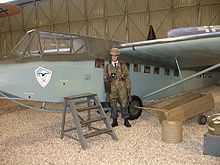
DFS 230-A at Luftwaffenmuseum der Bundeswehr
The DFS 230 was a German transport glider operated by the Luftwaffe in World War II. It was developed in 1933 by the Deutsche Forschungsanstalt für Segelflug (DFS - "German Research Institute for Sailplane Flight") with Hans Jacobs as the head designer. The glider was the German inspiration for the British Hotspur glider and was intended for paratrooper assault operations.
The glider could carry 9 soldiers with equipment or a payload of about 1,200 kg. They were used in the landings at Fort Eben-Emael and Crete, as well as in North Africa and in the rescue of Benito Mussolini and for supplying the defenders of Festung Budapest, until February 12, 1945.
Variants
- DFS 230 A-1
- Initial production version
- DFS 230 A-2
- A-1 with dual-controls
- DFS 230 B-1
- Braking parachute added, able to carry defensive armament (MG 34 machine gun)
- DFS 230 B-2
- B-1 with dual-controls
- DFS 230 C-1
- Late production version; B-1 with nose braking rockets
- DFS 230 D-1
- C-1 with improved nose braking rocket design, one prototype (DFS 230 V6)
- DFS 230 F-1
- Larger version with capacity for 15 soldiers, one prototype (DFS 230 V7, DV+AV)
Specifications (DFS 230 B-1)
Data from Aircraft of the Third Reich,[1] German Aircraft of the Second World War[2]
General characteristics
- Crew: 1
- Capacity: 9 equipped troops + 270 kg
- Length: 11.24 m (36 ft 11 in)
- Wingspan: 21.98 m (72 ft 1 in)
- Height: 2.74 m (9 ft 0 in)
- Wing area: 41.3 m2 (445 sq ft)
- Empty weight: 860 kg (1,896 lb)
- Gross weight: 2,040 kg (4,497 lb)
- Max takeoff weight: 2,100 kg (4,630 lb)
Performance
- Never exceed speed: 290 km/h (180 mph; 157 kn)
- Maximum towing speed: 209 km/h (130 mph)
- Normal towing speed: 180 km/h (112 mph)
- Maximum glide ratio: 1:11 (empty), 1:18 (fully loaded)
Armament
- Guns:
- 1 x 7.92 mm (0.312 in) MG 15 machine gun on a manually aimed mounting aft of the cockpit
- 2 x 7.92 mm MG 34 fixed forward firing machine guns attached to the forward fuselage sides.
See also
- Related development
- Aircraft of comparable role, configuration and era
- Related lists
Notes
- ↑ Green, William (2010). Aircraft of the Third Reich (1st ed.). London: Aerospace Publishing Limited. pp. 136–144. ISBN 978-1-900732-06-2.
- ↑ Smith, J.R.; Anthony L. Kay (1990). German Aircraft of the Second World War (7th impression ed.). London: Putnam. ISBN 978-0-85177-836-5.
Bibliography
- Smith, J.R.; Anthony L. Kay (1990). German Aircraft of the Second World War (7th impression ed.). London: Putnam. ISBN 978-0-85177-836-5.
External links
|
|---|
| | 1 to 100 | |
|---|
| | 101 to 200 | |
|---|
| | 201 to 300 | |
|---|
| | 301- | |
|---|
|
|
|---|
| | General | |
|---|
| | Military | |
|---|
| | Accidents/incidents | |
|---|
| | Records | |
|---|
|
